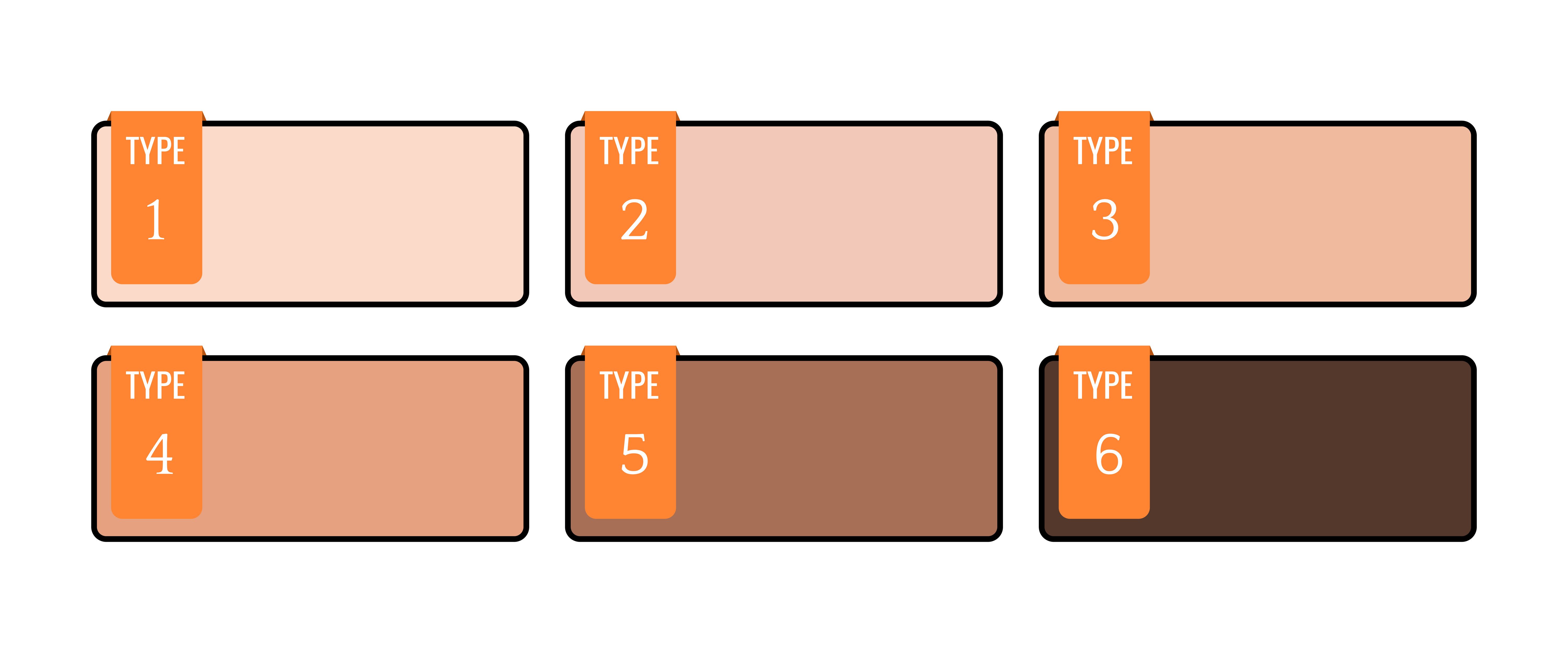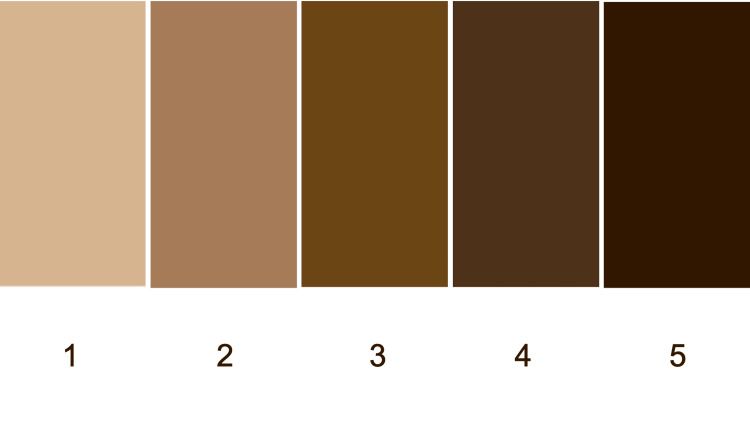- Acne
- Actinic Keratosis
- Aesthetics
- Alopecia
- Atopic Dermatitis
- Buy-and-Bill
- COVID-19
- Case-Based Roundtable
- Chronic Hand Eczema
- Chronic Spontaneous Urticaria
- Drug Watch
- Eczema
- General Dermatology
- Hidradenitis Suppurativa
- Melasma
- NP and PA
- Pediatric Dermatology
- Pigmentary Disorders
- Practice Management
- Precision Medicine and Biologics
- Prurigo Nodularis
- Psoriasis
- Psoriatic Arthritis
- Rare Disease
- Rosacea
- Skin Cancer
- Vitiligo
- Wound Care
News
Article
Colorimetric Scale Offers Practical Classification in Clinical Assessment of Skin of Color
Author(s):
Skin cancer risk classification lacks reliability for darker skin tones and fails in evaluating cutaneous medical conditions or cosmetic interventions, according to creators of the scale.
Fitzpatrick skin phototypes

Skin color classification is a crucial aspect of dermatology and forensic pathology, influencing medical assessments and post-mortem evaluations.
The current model of classification, the Fitzpatrick scale, was established in 1975 and has since become the traditional classification system for sun-reactive skin types to categorize patients with skin of color. It was originally developed in the context of PUVA (Psoralen plus Ultraviolet A) treatment for psoriasis, as it was necessary to classify individuals based on their skin type, particularly those with white skin. The classification aided in determining the appropriate dosage of ultraviolet A radiation in Joules per square centimeter for treatment.1
In the initial iteration, the Fitzpatrick scale excluded patients with black or brown skin. Non-white skin types were only considered beginning with the 1976 revision of the scale.1 Its current use has evolved to encompass several factors, including skin type, skin color of unexposed skin, erythema reaction, tanning reaction, and likelihood of sunburn and tan.
In the time since, researchers have attempted to develop color scales for individuals with skin of color.
In 2003, Martin and Massey developed a scale with an image depicting 10 hands emerging from a white shirt, numbered 1 to 10, with 0 representing the lightest skin color, akin to that of albinism. In a new immigrant survey, interviewers rated respondents' skin color on this scale, aiding investigators in determining their skin tone.2
Most recently, in 2019, the Monk scale was developed, with an image featuring 10 circles with longitudinal bands labeled A to J. The scale was devised for social psychology and categorization, particularly to assess racial and ethnic inequalities. Google collaborated with Monk to utilize this scale in developing applications for artificial intelligence and machine learning technologies.3
While the Fitzpatrick scale has served as a tool for clinicians, dermatologists, and pathologists for decades, it classifies individuals as only white, brown, or black.
"Unfortunately, this classification system does not provide reliable information with regard to the risk of skin cancer for individuals with darker skin color and does not aid in the evaluation of medical conditions with cutaneous involvement or assessment of appropriate cosmetic interventions for aesthetic management," wrote authors of a study published late last year in Cureus.4
Cohen et al.'s novel colorimetric scale. Image courtesy of Cureus, Cohen et al.

The study, titled, "Colorimetric Scale for Skin of Color: A Practical Classification Scale for the Clinical Assessment, Dermatology Management, and Forensic Evaluation of Individuals With Skin of Color," was written by dermatologist Philip R. Cohen, MD; forensic pathologist Michelle A. DiMarco, MD; forensic pathologist Rachel L. Geller, MD; and forensic pathologist Lora A. Darrisaw, MD.
They argued that traditional classification systems, such as the Fitzpatrick scale, fall short in accurately categorizing individuals with skin of color, leading to potential misdiagnoses and inadequate treatments. In turn, they developed a novel colorimetric scale, devoid of racial or ethnic biases, in an effort to present a promising solution to address these shortcomings.
The proposed colorimetric scale offers a straightforward method for classifying skin tones among individuals of color, ranging from very light beige to very dark brown. In total, the scale includes a range of 5 classifying skin tones, with 1 representing light beige tones to 5 representing dark brown tones.
Unlike previous classifications, the scale does not rely on racial or ethnic distinctions but instead provides a numerical designation based on observed skin color, according to researchers. This approach aims to facilitate clinical assessments by allowing quick visual evaluation during patient examinations.
"A scale that is not based on race or ethnicity is useful for categorizing individuals with skin of color not only for sociologists but also for clinicians who treat these patients," wrote Cohen et al. "In dermatology, a simple and rapidly performed determination to categorize persons with skin of color using a colorimetric scale can be helpful for predicting their risk for developing skin cancer and for assessing appropriate cosmetic procedures and devices for these patients. In forensic pathology, a colorimetric scale for deceased individuals enables the person performing the autopsy to provide a non-racial and non-ethnic designation of skin color type for the person."
The scale is aimed at aiding in predicting skin cancer risk and determining suitable cosmetic procedures for patients with skin of color. Moreover, it serves to provide a non-racial classification of skin color during assessments and autopsies.
"In summary, the scale will enhance the ability of dermatologists to categorize persons with skin of color, allowing them to better assess skin cancer risk and appropriate aesthetic procedures and devices for these individuals," wrote authors Cohen et al. "In addition, it will also enable the forensic pathologist and other clinicians to provide a non-racial and non-ethnic designation of skin color type for their patients."
References
- The validity and practicality of sun-reactive skin types I through VI. Fitzpatrick TB. Arch Dermatol. 1988. Accessed April 25, 2024.
- Massey DS, Martin JA. The NIS skin color scale. Princeton, New Jersey: Office of Population Research, Princeton University; 2003. The NIS skin color scale. Office of Population Research, Princeton University. Accessed April 25, 2024.
- The Monk skin tone scale (MST) [PREPRINT] [ Oct; 2023 ];Monk EP, Jr Jr. SocArXiv. 2023. Accessed April 25, 2024.
- Cohen PR, DiMarco MA, Geller RL, Darrisaw LA. Colorimetric scale for skin of color: A practical classification scale for the clinical assessment, dermatology management, and forensic evaluation of individuals with skin of color. Cureus. November 1, 2023 Accessed April 25, 2024. doi:10.7759/cureus.48132
Newsletter
Like what you’re reading? Subscribe to Dermatology Times for weekly updates on therapies, innovations, and real-world practice tips.














